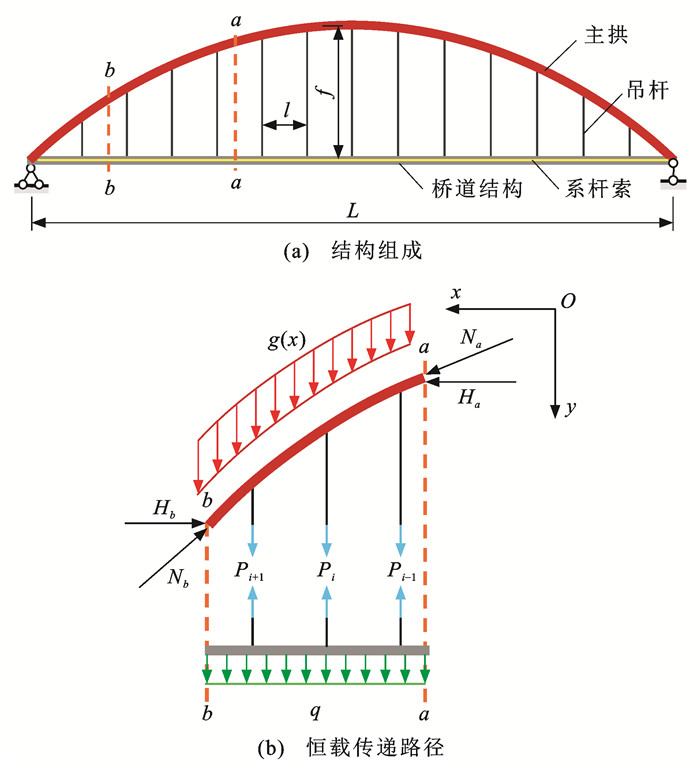Analytical solution and calculation method of reasonable arch axis of through arch bridge
-
摘要: 为了得到下承式拱桥合理拱轴线的解析解与计算方法,建立了恒载作用模式和合理拱轴线微分方程,得到合理拱轴线的解析解;在解析解的基础上,定义了主拱恒载占比系数,得到了基于矢跨比和主拱恒载占比系数的合理拱轴线快速求解计算方法;采用拱桥设计规范、工程案例与相关研究成果,验证了本文方法的可靠性。研究结果表明:下承式拱桥的恒载作用模式可等效为连续均布恒载+主拱恒载的形式,合理拱轴线为悬链线,相应的拱轴系数由矢跨比和主拱恒载占比系数共同决定;拟合出的不同矢跨比下的拱轴系数与主拱恒载占比系数的函数关系式为线性相关关系,决定系数大于0.99,说明拟合公式准确;工程中下承式拱桥矢跨比范围为1/3~1/8,相应的拱轴系数范围为1.000~1.792,常见的矢跨比范围为1/4~1/5,相应的拱轴系数范围为1.000~1.465,与工程案例中拱轴系数统计结果的吻合度较高,说明计算结果可靠;工程中常见主拱恒载占比系数范围为0.1~0.5,对应的拱轴系数范围为1.102~1.364,与拱桥设计规范中的取值范围接近,证明了规范取值的合理性;当主拱恒载占比系数小于0.5且矢跨比小于1/7,或主拱恒载占比系数小于0.1时,拱轴系数接近于1.000,即合理拱轴线可采用二次抛物线;利用查表法或简化公式法,可以快速求得合理拱轴线方程;与已有研究成果相比较,主拱截面弯矩、偏心距和偏心距平方和的偏差均在5%以内,证明了本文计算方法的正确性。Abstract: To obtain the analytical solution and calculation method of the reasonable arch axis of through arch bridge, the dead load action mode and differential equation of the reasonable arch axis were established, and the analytical solution of the reasonable arch axis was determined. Based on the analytical solution, the dead load ratio of main arch was defined. Based on the rise-span ratio and dead load ratio of main arch, a quick calculation method of the reasonable arch axis was obtained. The reliability of the proposed method was confirmed by arch bridge design specifications, engineering cases, and related research achievements. Research results show that the dead load action mode of through arch bridge can be equivalent to the combination of continuous uniform dead load and arch dead load, the reasonable arch axis is catenary, and the corresponding arch axis coefficient is determined by the rise-span ratio and dead load ratio of main arch. The fitted functional relationships between the arch axis coefficients and dead load ratios of main arch under different rise-span ratios are a linear correlation, and the determination coefficients are greater than 0.99, indicating that the fitted equations are accurate. The rise-span ratio of through arch bridge is between 1/3 and 1/8 in engineerings, and the range of the corresponding arch axis coefficient is between 1.000 and 1.792. The common rise-span ratio ranges from 1/4 to 1/5, and the corresponding arch axis coefficient ranges from 1.000 to 1.465. The calculation results are in good agreement with the statistical results of arch axis coefficients of engineering cases, indicating that the calculation results are reliable. The common dead load ratio of main arch ranges from 0.1 to 0.5, and the corresponding arch axis coefficient ranges from 1.102 to 1.364. The calculation results are close to the value ranges in the arch bridge design specification, which proves the rationality of value range in the arch bridge design specification. When the dead load ratio of main arch is less than 0.5 and the rise-span ratio is less than 1/7, or the dead load ratio of main arch is less than 0.1, the arch axis coefficient is close to 1.000. As a result, the quadratic parabola can be used as reasonable arch axis. The reasonable arch axis equation can be obtained quickly by the look-up table method and simplified formula method. Compared with the mature research achievements, the deviations of bending moments, eccentricities and sums of squared eccentricities of main arch cross-section are within 5%, which proves the correctness of the solution method.
-
表 1 十座拱桥λ的统计结果
Table 1. λ statistical results of 10 arch bridges
序号 结构型式 跨径/m 桥宽/m 矢跨比 截面型式 桥道结构 桥道梁跨径/m 主拱恒载占比系数 1 钢管混凝土拱桥 46.0 18.0 1/3 单圆管型 钢筋混凝土结构 4.0 0.119 2 钢管混凝土拱桥 75.0 18.0 1/5 哑铃型 钢筋混凝土结构 4.7 0.176 3 钢管混凝土拱桥 95.5 22.4 2/9 哑铃型 钢筋混凝土结构 7.1 0.316 4 钢管混凝土拱桥 100.0 5.5 1/5 哑铃型 钢筋混凝土结构 4.1 0.251 5 钢箱拱桥 118.0 39.4 1/4 箱型 钢-混组合结构 6.0 0.110 6 钢管混凝土拱桥 136.0 11.5 1/5 桁架型 钢筋混凝土结构 8.1 0.352 7 钢管混凝土拱桥 150.0 23.5 2/9 桁架型 钢筋混凝土结构 8.0 0.431 8 钢筋混凝土拱桥 280.0 26.0 1/5 箱型 钢筋混凝土结构 12.0 0.485 9 钢管混凝土拱桥 300.0 24.0 2/11 桁架型 钢筋混凝土结构 10.0 0.337 10 钢桁拱桥 390.0 12.0 2/9 桁架型 钢-混组合结构 12.0 0.459 表 2 拱轴系数计算结果
Table 2. Calculation results of arch axis coefficients
主拱恒载占比系数 矢跨比 1/3 1/4 1/5 1/6 1/7 1/8 0.0 1.000 1.000 1.000 1.000 1.000 1.000 0.1 1.068 1.042 1.028 1.020 1.015 1.012 0.2 1.138 1.085 1.057 1.041 1.031 1.024 0.3 1.211 1.129 1.086 1.062 1.046 1.036 0.4 1.286 1.174 1.116 1.083 1.062 1.048 0.5 1.364 1.220 1.146 1.104 1.078 1.060 0.6 1.444 1.267 1.177 1.126 1.094 1.072 0.7 1.527 1.315 1.208 1.148 1.110 1.085 0.8 1.612 1.364 1.240 1.170 1.126 1.097 0.9 1.701 1.414 1.272 1.192 1.143 1.110 1.0 1.792 1.465 1.305 1.215 1.159 1.123 表 3 十座拱桥拱轴系数计算结果
Table 3. Calculation results of arch axis coefficients of 10 arch bridges
序号 跨径/m 矢跨比 主拱恒载占比系数 本文计算拱轴系数 原设计拱轴系数 拱轴系数偏差 1 46 1/3 0.119 1.075 1.000 -0.075 2 75 1/5 0.176 1.050 1.000 -0.050 3 96 2/9 0.316 1.116 1.347 0.231 4 100 1/5 0.251 1.073 1.167 0.094 5 118 1/4 0.110 1.044 1.100 0.056 6 136 1/5 0.352 1.103 1.167 0.064 7 150 2/9 0.431 1.160 1.167 0.007 8 280 1/5 0.485 1.144 1.167 0.023 9 300 2/11 0.337 1.085 1.100 0.015 10 390 2/9 0.459 1.171 1.200 0.029 表 4 不同f/L下λ与m的关系式拟合结果
Table 4. Fitting results of relationships between λ and m under different rise-span ratios
矢跨比 拟合公式 决定系数 公式编号 1/3 m=0.791 3λ+0.981 0 0.997 9 (22) 1/4 m=0.465 0λ+0.992 5 0.999 1 (23) 1/5 m=0.305 0λ+0.996 1 0.999 5 (24) 1/6 m=0.215 0λ+0.998 0 0.999 7 (25) 1/7 m=0.159 3λ+0.998 9 0.999 9 (26) 1/8 m=0.122 5λ+0.998 9 0.999 9 (27) 表 5 拱轴线坐标
Table 5. Arch axis coordinates
水平向坐标/m 竖向坐标/m 水平向坐标/m 竖向坐标/m 0.000 0.000 39.000 8.010 3.000 0.048 42.000 9.297 6.000 0.190 45.000 10.681 9.000 0.426 48.000 12.164 12.000 0.757 51.000 13.744 15.000 1.179 54.000 15.422 18.000 1.671 57.000 17.202 21.000 2.316 60.000 19.081 24.000 3.026 63.000 21.061 27.000 3.831 66.000 23.143 30.000 4.731 69.000 25.327 33.000 5.727 72.000 27.614 36.000 6.820 75.000 30.000 表 6 最大弯矩和最大偏心距计算结果
Table 6. Calculation results of maximum bending moments and maximum eccentricities
方法 三铰拱 无铰拱 最大弯矩/(kN·m) 最大偏心距/m 最大弯矩/(kN·m) 最大偏心距/m 偏心距平方和/m2 本文方法 17.5 -0.002 -1 455.3 0.112 0.182 五点重合法 345.7 -0.030 -1 739.3 0.134 0.196 唐春艳[19]的方法 -39.0 0.003 -1 415.0 0.109 0.186 任伟新等[17]的方法 -23.6 0.002 -1 429.7 0.110 0.182 Lewis[20]的方法 259.2 -0.021 -1 664.5 0.128 0.191 二次抛物线法 1 571.5 -0.136 -2 785.9 0.215 0.256 -
[1] BLOCK P, DEJONG M, OCHSENDORF J. As hangs the flexible line: equilibrium of masonry arches[J]. Nexus Network Journal, 2006, 8(2): 13-24. doi: 10.1007/s00004-006-0015-9 [2] LEWIS W J, RUSSELL J M, LI T Q. Moment-less arches for reduced stress state. Comparisons with conventional arch forms[J]. Computers and Structures, 2021, 251: 106524. doi: 10.1016/j.compstruc.2021.106524 [3] NIKOLI AC'G D. Catenary arch of finite thickness as the optimal arch shape[J]. Structural and Multidisciplinary Optimization, 2019, 60(5): 1957-1966. doi: 10.1007/s00158-019-02304-9 [4] 陈宝春, 刘君平. 世界拱桥建设与技术发展综述[J]. 交通运输工程学报, 2020, 20(1): 27-41. https://www.cnki.com.cn/Article/CJFDTOTAL-JYGC202001005.htmCHEN Bao-chun, LIU Jun-ping. Review of construction and technology development of arch bridges in the world[J]. Journal of Traffic and Transportation Engineering, 2020, 20(1): 27-41. (in Chinese) https://www.cnki.com.cn/Article/CJFDTOTAL-JYGC202001005.htm [5] ZHANG Guo-jing, LIU Yong-jian, ZHAO Wei, et al. Optimal arch shape of long-span open-spandrel arch bridges under vertical permanent loads[J]. Structures, 2022, 45: 1012-1030. doi: 10.1016/j.istruc.2022.09.086 [6] 侯春辉, 宋顺心. 基于APDL语言的拱轴线优化及立柱布置研究[J]. 铁道工程学报, 2017, 34(10): 55-59. https://www.cnki.com.cn/Article/CJFDTOTAL-TDGC201710011.htmHOU Chun-hui, SONG Shun-xin. Research on the optimization of arch-axis and column layout based on APDL language[J]. Journal of Railway Engineering Society, 2017, 34(10): 55-59. (in Chinese) https://www.cnki.com.cn/Article/CJFDTOTAL-TDGC201710011.htm [7] 宰国军, 周志祥. 钢箱砼组合拱桥的拱轴线优化算法研究[J]. 土木建筑与环境工程, 2014, 36(S1): 20-23. https://www.cnki.com.cn/Article/CJFDTOTAL-JIAN2014S1006.htmZAI Guo-jun, ZHOU Zhi-xiang. Optimization algorithm research on the arch axis of steel box-concrete composite arch bridge[J]. Journal of Civil, Architectural and Environmental Engineering, 2014, 36(S1): 20-23. (in Chinese) https://www.cnki.com.cn/Article/CJFDTOTAL-JIAN2014S1006.htm [8] 蒋启平. 三次样条插值确定拱桥合理拱轴线的方法探讨[J]. 武汉理工大学学报(交通科学与工程版), 2001, 25(1): 101-104. https://www.cnki.com.cn/Article/CJFDTOTAL-JTKJ200101027.htmJIANG Qi-ping. A study of method of determining rational arch axis using three ordersplin interpolation[J]. Journal of Wuhan University of Technology (Transportation Science and Engineering), 2001, 25(1): 101-104. (in Chinese) https://www.cnki.com.cn/Article/CJFDTOTAL-JTKJ200101027.htm [9] 罗辉. 一种新型的拱轴线及拱圈优化设计[J]. 桥梁建设, 1997, 27(2): 14-17. https://www.cnki.com.cn/Article/CJFDTOTAL-QLJS702.002.htmLUO Hui. Anew type of arch axis curve and optimization design of arch ring[J]. Bridge Construction, 1997, 27(2): 14-17. (in Chinese) https://www.cnki.com.cn/Article/CJFDTOTAL-QLJS702.002.htm [10] ZHANG Xue-song, LIANG Ning-yi, LU Xiao-hong, et al. Optimization method for solving the reasonable arch axis of long-span CFST arch bridges[J]. Advances in Civil Engineering, 2019, 2019: 7235656. [11] 刘毓湘, 高敬红. 基于4次样条函数拱轴线优化设计的T-V求解法[J]. 公路交通科技, 2007, 24(6): 80-85. https://www.cnki.com.cn/Article/CJFDTOTAL-GLJK200706018.htmLIU Yu-xiang, GAO Jing-hong. Topkis-Veinott feasible direction method for optimum axis of arch bridge based on quartic spline function[J]. Journal of Highway and Transportation Research and Development, 2007, 24(6): 80-85. (in Chinese) https://www.cnki.com.cn/Article/CJFDTOTAL-GLJK200706018.htm [12] 范重, 胡纯炀, 刘先明, 等. 鄂尔多斯东胜体育场巨型拱索结构设计优化[J]. 建筑结构学报, 2016, 37(6): 9-18. https://www.cnki.com.cn/Article/CJFDTOTAL-JZJB201606002.htmFAN Zhong, HU Chun-yang, LIU Xian-ming, et al. Optimized design of giant arch-cable structure of the Ordos Dongsheng Stadium[J]. Journal of Building Structures, 2016, 37(6): 9-18. (in Chinese) https://www.cnki.com.cn/Article/CJFDTOTAL-JZJB201606002.htm [13] SHI Zhou, HU Hao, LI Jia-qi. Axis optimization of arch-shaped pylons for high-speed railway cable-stayed bridges[J]. Engineering Structures, 2021, 227: 111424. [14] NODARGI N A, BISEGNA P. Thrust line analysis revisited and applied to optimization of masonry arches[J]. International Journal of Mechanical Sciences, 2020, 179: 105690. [15] MICHIELS T, NAPOLITANO R, ADRIAENSSENS S, et al. Comparison of thrust line analysis, limit state analysis and distinct element modeling to predict the collapse load and collapse mechanism of a rammed earth arch[J]. Engineering Structures, 2017, 148: 145-156. [16] NIKOLICH D. Thrust line analysis of triangular arches[J]. Archive of Applied Mechanics, 2020, 90(9): 1861-1874. [17] 任伟新, 胡常福, 上官兴, 等. 空腹式拱桥新型拱轴线研究[J]. 交通科学与工程, 2010, 26(2): 26-30, 47. https://www.cnki.com.cn/Article/CJFDTOTAL-CSJX201002006.htmREN Wei-xin, HU Chang-fu, SHANGGUAN Xing, et al. Research on new arch axis of open-spandrel arch bridge[J]. Journal of Transport Science and Engineering, 2010, 26(2): 26-30, 47. (in Chinese) https://www.cnki.com.cn/Article/CJFDTOTAL-CSJX201002006.htm [18] 胡常福, 廖妙星. 多源荷载作用下合理拱轴的近似解析[J]. 华东交通大学学报, 2018, 35(2): 46-55. https://www.cnki.com.cn/Article/CJFDTOTAL-HDJT201802007.htmHU Chang-fu, LIAO Miao-xing. Approximate analytical solution for rational arch axis under multi-type loads[J]. Journal of East China Jiaotong University, 2018, 35(2): 46-55. (in Chinese) https://www.cnki.com.cn/Article/CJFDTOTAL-HDJT201802007.htm [19] 唐春艳. T构-系杆拱组合体系桥静力及动力性能研究[D]. 大连: 大连理工大学, 2018.TANG Chun-yan. Research on the static and dynamic characteristics of T-frame and tied arch composite bridge[D]. Dalian: Dalian University of Technology, 2018. (in Chinese) [20] LEWIS W J. Mathematical model of a moment-less arch[J]. Proceedings of the Royal Society A: Mathematical, Physical, and Engineering Sciences, 2016, 472: 20160019. [21] GIL-MARTÍN L M, HERNÁNDEZ-MONTES E, PALOMARES A, et al. The optimum shape of an arch under non-symmetric loading conditions[J]. Archive of Applied Mechanics, 2016, 86(8): 1509-1520. [22] MARANO G C, TRENTADUE F, PETRONE F. Optimal arch shape solution under static vertical loads[J]. Acta Mechanica, 2014, 225(3): 679-686. [23] LEWIS W J. Constant stress arches and their design space[J]. Proceedings of the Royal Society A: Mathematical, Physical, and Engineering Sciences, 2022, 478: 20210428. [24] 陈宝春, 韦建刚, 周俊, 等. 我国钢管混凝土拱桥应用现状与展望[J]. 土木工程学报, 2017, 50(6): 50-61. https://www.cnki.com.cn/Article/CJFDTOTAL-TMGC201706006.htmCHEN Bao-chun, WEI Jian-gang, ZHOU Jun, et al. Application of concrete-filled steel tube arch bridges in China: current status and prospects[J]. China Civil Engineering Journal, 2017, 50(6): 50-61. (in Chinese) https://www.cnki.com.cn/Article/CJFDTOTAL-TMGC201706006.htm [25] 易云焜. 梁拱组合体系设计理论关键问题研究[D]. 上海: 同济大学, 2007.YI Yun-kun. Key problem study for design theory of beam-arch association bridges[D]. Shanghai: Tongji University, 2007. (in Chinese) [26] SALONGA J, GAUVREAU P. Comparative study of the proportions, form, and efficiency of concrete arch bridges[J]. Journal of Bridge Engineering, 2014, 19(3): 04013010. -





 下载:
下载:


















